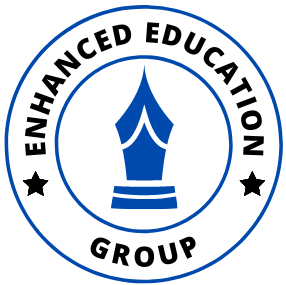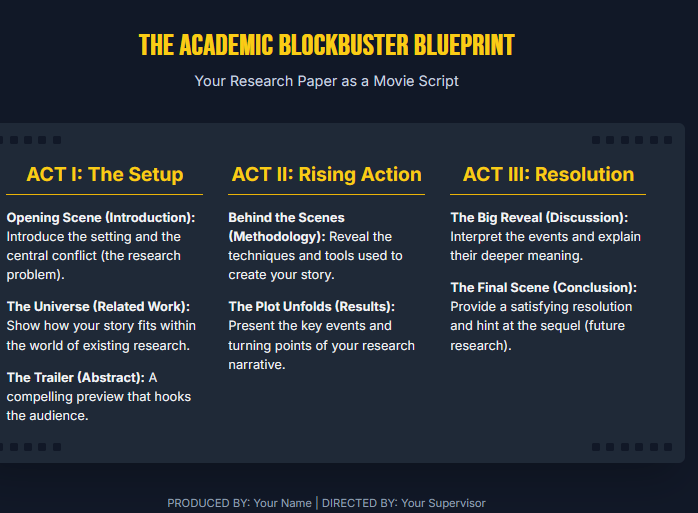In the world of academia, the process of writing a research paper can often feel like a technical, daunting task. But what if you approached it not as a scholar, but as a storyteller? Imagine for a moment that you are the director of a blockbuster movie. Your research is the plot, your data are the characters, and your manuscript is the script.
This simple shift in perspective can transform the way you write, turning a dry exercise into an exciting narrative adventure. It helps you focus on what truly matters: creating a clear, compelling story that captivates your audience from the opening scene to the final credits.
So, grab your director’s chair. Let’s break down how to craft your next research paper as if it were an academic blockbuster.
Act I: The Setup – Establishing the World and the Conflict
The first act of any great film establishes the world, introduces the main characters, and presents the central conflict that will drive the story. Your paper’s opening sections do the exact same thing.
- The Title & Abstract (Your Movie Poster & Trailer):
Just as a movie poster and trailer grab the audience's attention, your Title and Abstract are your first and best chance to sell your story. The title should be both informative and intriguing, hinting at the core theme. The abstract is your trailer—a concise, compelling preview that highlights the background, the central conflict (the research problem), and a glimpse of the thrilling conclusion, all without giving away the entire plot. - The Introduction (The Opening Scene):
This is where your film begins. You introduce the setting (the broader research context) and the protagonist (your specific topic). Most importantly, you introduce the inciting incident: the research problem. A great opening scene doesn't just show a happy world; it reveals a tension or a question that needs to be answered. Your introduction must do the same, creating a sense of urgency that makes the reader care about the problem you are about to solve. - The Related Work (Establishing the Cinematic Universe):
No movie exists in a vacuum. The Related Work section is where you place your story within its "cinematic universe." You show your audience the other films (studies) that have come before, what they accomplished, and—most critically—what they left unresolved. This demonstrates your mastery of the genre and solidifies the novelty and importance of your own story.
Act II: The Rising Action – Developing the Plot
The second act is where the story develops. The protagonist faces challenges, uncovers clues, and moves toward the inevitable climax. In your paper, this is where you detail your journey of discovery.
- The Methodology (Behind the Scenes):
This section is like the "making-of" documentary. You pull back the curtain and show your audience exactly how you brought your story to life. What special effects (methods), camera work (data collection), and editing techniques (analysis) did you use? Justifying your production choices here builds trust and convinces the audience of your film's credibility and rigor. - The Results (The Main Events & Plot Twists):
This is the core of your narrative, where the action happens. You present your findings as the main events of your story. Don't just list data; present it as a sequence of discoveries or turning points. Are there unexpected results? That's a plot twist! This section should be clear, dramatic, and move your story forward with momentum, leading your reader toward the climax.
Act III: The Climax and Resolution – Delivering the Payoff
The final act is where everything comes together. The conflict is faced, the meaning is revealed, and the story reaches a satisfying conclusion.
- The Discussion (The Climax and Deeper Meaning):
This is more than just a summary of the events; it's the climax, where the true meaning of your findings is revealed. Here, you interpret your results, explain their significance, and connect them back to the central conflict you introduced in the opening scene. Like a great movie critique, you analyze the strengths and weaknesses of your findings and place them in a broader context. - The Conclusion (The Final Scene & Sequel Hook):
Your Conclusion is the final scene of your film. It provides a sense of closure by summarizing the journey and reinforcing the main takeaway message. But a truly great ending also looks forward. It hints at the "sequel"—the unanswered questions and future research directions that your work has inspired, leaving your audience thinking long after the credits have rolled.
Final Scene
By reimagining your research paper as a cinematic adventure, you transform the writing process from a daunting task into a creative one. You become a director, focused on telling a clear, compelling, and impactful story. So, the next time you sit down to write, remember your role.
Lights, camera, research!
Frequently Asked Questions (FAQ)
- What if my research topic feels too technical or "boring" to be a story?
Every research project has a story because every project starts with a problem. The "story" isn't about adding fictional drama; it's about structuring your communication around a core narrative: "There was a problem (the gap), we went on a journey to solve it (the methods), and here is what we discovered (the results) and what it means (the discussion)." - How do I find the "conflict" in my research?
The conflict is the research gap. It's the tension between what is known and what is unknown. Your job as the "director" is to make the audience feel why that gap is a problem that needs to be solved. - Is this approach just about making my paper more entertaining?
Not at all. It's about making it more effective. Story structure is one of the most powerful tools we have for communicating complex information clearly and memorably. Thinking like a storyteller forces you to clarify your core message, create a logical flow, and focus on the aspects of your work that are most impactful to your audience.


